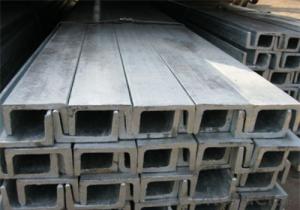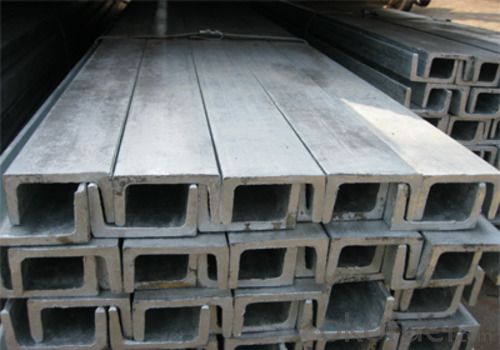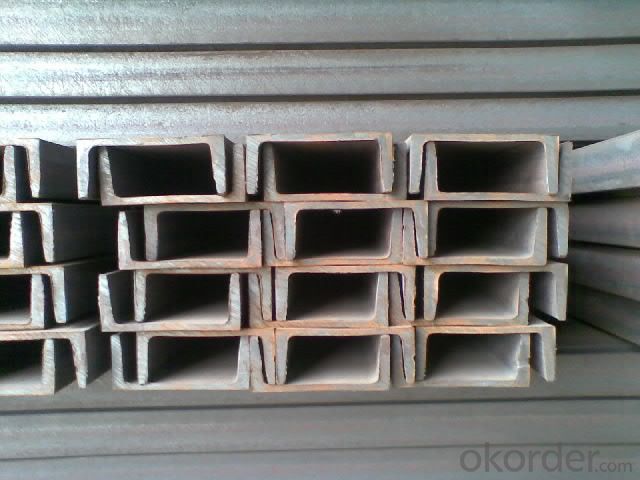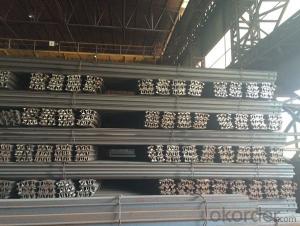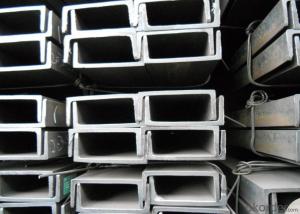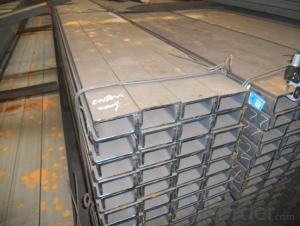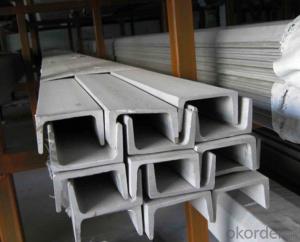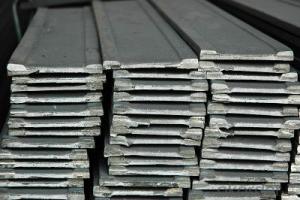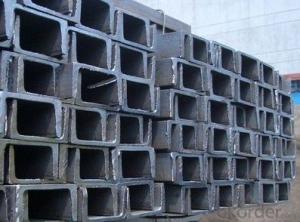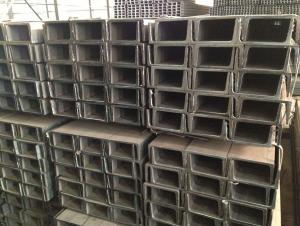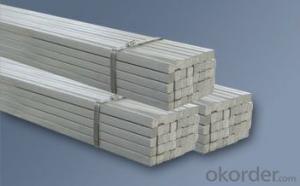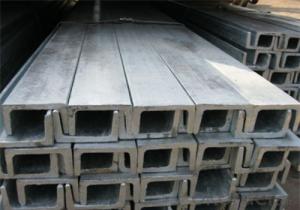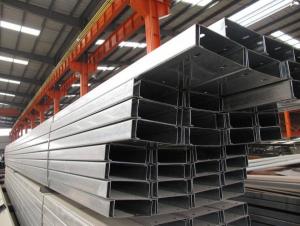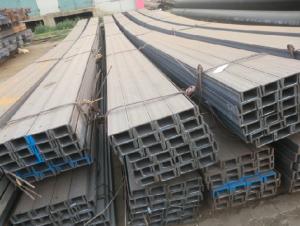Channel Steel Bar U Channel Iron Bar Q235B
- Loading Port:
- Tianjin
- Payment Terms:
- TT or LC
- Min Order Qty:
- 30 m.t.
- Supply Capability:
- 40000 m.t./month
OKorder Service Pledge
OKorder Financial Service
You Might Also Like
Product Description:
OKorder is offering Channel Steel Bar U Channel Iron Bar Q235B at great prices with worldwide shipping. Our supplier is a world-class manufacturer of steel, with our products utilized the world over. OKorder annually supplies products to European, North American and Asian markets. We provide quotations within 24 hours of receiving an inquiry and guarantee competitive prices.
Product Applications:
Channel Steel Bar U Channel Iron Bar Q235B are ideal for structural applications and are widely used in the construction of buildings and bridges, and the manufacturing, petrochemical, and transportation industries.
Product Advantages:
OKorder's Channel Steel Bar U Channel Iron Bar Q235B are durable, strong, and resist corrosion.
Main Product Features:
· Premium quality
· Prompt delivery & seaworthy packing (30 days after receiving deposit)
· Corrosion resistance
· Can be recycled and reused
· Mill test certification
· Professional Service
· Competitive pricing
Product Specifications:
1) Dimensions: 5# ~ 30#
2) Spec.: Q235B, Q345B, SS400, A36, A572, A992 Gr50, S235JRG2, S235JR, S275JR and
S335JR
3) Length: 6 ~ 12m
4) Standard: GB/T707-88, JIS, ASTM and EN
5) We can supply random lengths as per buyers' requirements
Packing: In bundle or bulk
| Size(mm) | Model | Weight(kg/m) |
| 50*37*4.5 | 5# | 5.44 |
| 63*40*4.8 | 6.3# | 6.635 |
| 65*40*4.8 | 6.5# | 6.7 |
| 80*43*5 | 8# | 8.045 |
| 100*48*5.3 | 10# | 10.007 |
| 120*53*5.5 | 12# | 12.37 |
| 140*60*8 | 14#A | 14.53 |
| 140*60*8 | 14#B | 16.73 |
| 160*63*6.5 | 16#A | 17.23 |
| 160*65*8.5 | 16#B | 19.755 |
| 180*68*7 | 18#A | 20.17 |
| 180*70*9 | 18#B | 23 |
| 200*73*7 | 20#A | 22.637 |
| 200*75*9 | 20#B | 25.777 |
| 220*77*7 | 22#A | 24.999 |
| 220*79*9 | 22#B | 28.453 |
| 240*78*7 | 24#A | 26.68 |
| 240*80*9 | 24#B | 30.628 |
| 250*78*7 | 25#A | 27.41 |
| 250*80*9 | 25#B | 31.335 |
| 270*82*7.5 | 27#A | 30.838 |
| 270*84*9.5 | 27#B | 35.077 |
| 280*82*7.5 | 28#A | 31.427 |
| 280*84*9.5 | 28#B | 35.823 |
| 300*85*7.5 | 30#A | 34.463 |
| 300*87*9.5 | 30#B | 39.173 |
| 320*88*8 | 32#A | 38.083 |
| 320*90*10 | 32#B | 43.107 |
| 360*96*9 | 36#A | 47.814 |
| 360*98*11 | 36#B | 53.466 |
| 400*100*10.5 | 40#A | 58.928 |
| 400*102*12.5 | 40#B | 65.208 |
FAQ:
Q1: Why buy Materials & Equipment from OKorder.com?
A1: All products offered byOKorder.com are carefully selected from China's most reliable manufacturing enterprises. Through its ISO certifications, OKorder.com adheres to the highest standards and a commitment to supply chain safety and customer satisfaction.
Q2: How do we guarantee the quality of our products?
A2: We have established an advanced quality management system which conducts strict quality tests at every step, from raw materials to the final product. At the same time, we provide extensive follow-up service assurances as required.
Q3: How soon can we receive the product after purchase?
A3: Within three days of placing an order, we will begin production. The specific shipping date is dependent upon international and government factors, but is typically 7 to 10 workdays.
Images:

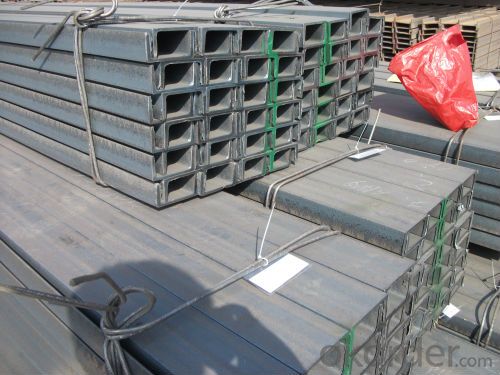
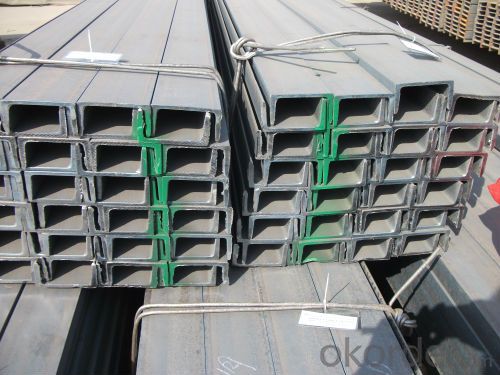
- Q: Can steel channels be used in the renewable energy sector?
- Certainly, the renewable energy sector can make excellent use of steel channels. These versatile structural components are widely employed and valued for their strength and durability. Within the renewable energy sector, there are various applications where steel channels can be utilized with great effectiveness. For instance, they can be employed in the construction of solar panel frames, wind turbine towers, and support structures for hydroelectric power plants. When it comes to solar energy, steel channels prove to be indispensable in the manufacturing of photovoltaic (PV) panel frames. These frames play a crucial role in providing structural support and ensuring the solar panels remain intact. Steel channels possess the necessary strength to withstand the weight of the panels, as well as external forces such as wind and snow loads. Similarly, in the wind energy sector, steel channels find extensive use in constructing wind turbine towers. These towers must possess strength and rigidity to endure the rotational forces generated by the blades, as well as the dynamic loads caused by wind. Steel channels offer the required structural support and can be easily fabricated into tower sections of varying heights. Additionally, steel channels are also highly suitable for the construction of support structures in hydroelectric power plants. These structures must be capable of withstanding the weight of turbines, generators, and other equipment, all while enduring the force exerted by flowing water. Given their high strength and load-bearing capacity, steel channels are exceptionally well-suited for such applications. To summarize, steel channels bring numerous advantages to the renewable energy sector, including strength, durability, and versatility. Their utilization contributes significantly to the development of robust and reliable renewable energy infrastructure.
- Q: What are the different fabrication techniques for steel channels?
- There are several different fabrication techniques for steel channels that are commonly used in the industry. These techniques involve various processes to shape, form, and assemble steel channels to meet specific requirements. Some of the most commonly used fabrication techniques for steel channels include: 1. Hot Rolling: This is the most common and widely used technique for fabricating steel channels. In this process, the steel is heated above its recrystallization temperature and passed through a series of rollers to form the desired shape. Hot rolling allows for the production of steel channels with consistent dimensions and excellent mechanical properties. 2. Cold Forming: Cold forming involves shaping steel channels at room temperature or slightly above using pressure and bending techniques. This technique is often used when precision is required, as it allows for tight tolerances and complex shapes. Cold-formed steel channels are commonly used in construction and manufacturing applications. 3. Welding: Welding is another fabrication technique used for steel channels. It involves joining two or more separate pieces of steel using heat and pressure to create a strong and durable bond. Welding can be done using various methods such as arc welding, gas welding, or laser welding. It is often used to create customized steel channel configurations or to repair damaged channels. 4. Cutting and Machining: Cutting and machining techniques are used to shape steel channels by removing excess material. Common methods include sawing, shearing, plasma cutting, waterjet cutting, and laser cutting. These techniques are utilized to achieve precise dimensions, create openings, or remove unwanted sections from steel channels. 5. Forming and Bending: Forming and bending techniques are used to give steel channels specific shapes or curves. This can be achieved through processes such as press braking, roll forming, or tube bending. Forming and bending allow for the creation of custom-designed steel channels that can fit specific applications or architectural requirements. 6. Surface Treatment: Surface treatment techniques are often applied to steel channels to enhance their corrosion resistance, aesthetic appearance, or to improve their functionality. Common surface treatments include galvanizing, powder coating, painting, or applying protective coatings. These treatments provide an additional layer of protection to steel channels and can extend their lifespan. In summary, the different fabrication techniques for steel channels include hot rolling, cold forming, welding, cutting and machining, forming and bending, and surface treatment. The choice of technique depends on the specific requirements of the project, such as dimensional accuracy, strength, and surface finish.
- Q: If the welding position is rusty, does it affect the life span? After all, the place of welding is thinner than the channel itself. If it is thick, it will not be afraid. The package is in the shed. How do you handle it?,
- It's no big deal. Although not in line with the norms, but usually no problem will be used.
- Q: How do steel channels contribute to the structural integrity of a building?
- Steel channels contribute to the structural integrity of a building in several ways. Firstly, they provide additional support and reinforcement to the structural framework, enhancing its overall strength and stability. Secondly, steel channels help distribute the load evenly across the building, reducing the risk of structural failure due to uneven weight distribution. Additionally, steel channels are resistant to bending and twisting forces, making them ideal for withstanding high-pressure and seismic activities. Overall, steel channels play a crucial role in improving the durability and safety of a building's structure.
- Q: How do steel channels contribute to the overall sustainability of a construction project?
- There are several ways in which steel channels contribute to the overall sustainability of a construction project. To begin with, they are manufactured using recycled materials, which reduces the demand for new resources and lessens the environmental impact of mining and processing raw materials. This helps conserve natural resources and reduces the energy needed for production, making steel channels a more sustainable choice. In addition, steel channels have a lengthy lifespan and require minimal maintenance. They are highly durable and resistant to corrosion, enabling them to withstand harsh weather conditions and endure for many years without needing replacement or frequent repairs. This reduces the overall use of materials and generation of waste, making the construction project more sustainable in the long term. Moreover, steel channels are lightweight and easy to transport. This decreases energy consumption and greenhouse gas emissions related to transportation, as less fuel is needed to move them from the manufacturing facility to the construction site. Furthermore, their lightweight nature makes them easier to handle and install, reducing the necessity for heavy machinery and the associated energy consumption during the construction process. Lastly, steel channels can be easily recycled at the end of their lifespan. Unlike other construction materials, steel can be melted down and reused multiple times without losing its properties. This not only reduces the amount of waste sent to landfills but also diminishes the need for new steel production, further conserving natural resources and decreasing environmental impact. To conclude, steel channels contribute to the overall sustainability of a construction project through their use of recycled materials, long lifespan, lightweight and easy transportability, and recyclability at the end of their life. By incorporating steel channels into construction projects, we can reduce environmental impact, conserve natural resources, and promote a more sustainable built environment.
- Q: What is the specific weight of 10# channel steel?
- Cold rolling edge channel (CJ/YB99-81 standard standard)The height of =120, legs wide =60, short width =20, thickness =3, leg end arc radius =3.0, cross-sectional area (cm2) =7.808, (kg/m) =6.090 theoretical weight (legs bent inward kind)
- Q: Can steel channels be used in the construction of solar panel mounting structures?
- Yes, steel channels can be used in the construction of solar panel mounting structures. Steel channels provide strong support and stability, making them suitable for holding the weight of solar panels and withstanding various environmental conditions.
- Q: What material is the channel steel bought in the steel market?
- Carbon structural steels are normally used directly under heat supply without heat treatment.
- Q: What are the different types of connections for steel channels in curtain wall systems?
- There are several types of connections used for steel channels in curtain wall systems, including bolted connections, welded connections, and adhesive connections. Bolted connections involve using bolts and nuts to secure the steel channels to the framing members. Welded connections involve melting the steel channels and the framing members together to create a strong bond. Adhesive connections involve using specialized adhesives to bond the steel channels to the framing members. Each type of connection has its own advantages and considerations depending on factors such as load requirements, ease of installation, and aesthetic preferences.
- Q: What are the different load-bearing tests conducted on steel channels?
- There are several load-bearing tests that are conducted on steel channels to assess their structural integrity and performance. These tests help determine the maximum load that a steel channel can bear without failure. Some of the different load-bearing tests conducted on steel channels include: 1. Tensile Test: This test measures the maximum tensile strength of the steel channel by applying a gradually increasing axial load until failure occurs. It helps assess the channel's ability to resist pulling or stretching forces. 2. Compression Test: This test determines the maximum compressive strength of the steel channel by applying a gradually increasing axial load until it buckles or collapses. It provides insights into the channel's ability to withstand compressive forces. 3. Bending Test: In this test, the steel channel is subjected to a gradually increasing load applied perpendicular to its length until it reaches its maximum bending capacity. It assesses the channel's resistance to bending or flexural forces. 4. Shear Test: The shear test measures the maximum shear strength of the steel channel by applying a force parallel to its cross-sectional area until it fails. It helps evaluate the channel's ability to withstand shearing forces. 5. Fatigue Test: This test involves subjecting the steel channel to repeated and varying loads over a specified period to simulate real-world usage conditions. It assesses the channel's resistance to fatigue and its ability to withstand cyclic loading. 6. Impact Test: In this test, a sudden and high-velocity load is applied to the steel channel to simulate impact or shock loading. It helps evaluate the channel's ability to absorb and dissipate energy without failure. 7. Buckling Test: This test is conducted to determine the critical load at which the steel channel buckles or collapses due to instability. It helps assess the channel's resistance to buckling under compressive loads. These load-bearing tests are crucial in ensuring the reliability and safety of steel channels in various applications, such as construction, manufacturing, and infrastructure. By conducting these tests, engineers can determine the load limits and performance characteristics of steel channels, allowing for informed design decisions and ensuring structural integrity.
Send your message to us
Channel Steel Bar U Channel Iron Bar Q235B
- Loading Port:
- Tianjin
- Payment Terms:
- TT or LC
- Min Order Qty:
- 30 m.t.
- Supply Capability:
- 40000 m.t./month
OKorder Service Pledge
OKorder Financial Service
Similar products
Hot products
Hot Searches
Related keywords
